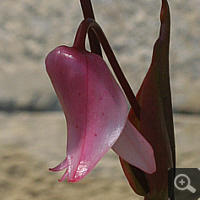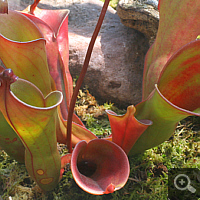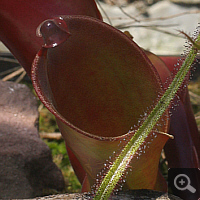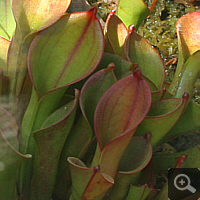Sun Pitcher (Heliamphora)
Overview
Sun Pitchers are a genus of the North American Pitcher Plant family with current 11 species (Heliamphora chimantensis, Heliamphora elongata, Heliamphora folliculata, Heliamphora heterodoxa, Heliamphora hispida, Heliamphora ionasii, Heliamphora minor, Heliamphora nutans, Heliamphora pulchella, Heliamphora sarracenioides, Heliamphora tatei) and 7 forms and varieties (Heliamphora heterodoxa f. glabra, Heliamphora heterodoxa var. exappendiculata, Heliamphora heterodoxa var. exappendiculata f. glabella, Heliamphora minor f. laevis, Heliamphora tatei f. macdonaldae, Heliamphora tatei var. neblinae, Heliamphora tatei var. neblinae f. parva), which are native in the northeast of South America. To be exact, the table mountains (tepuis) especially in the rainforest of Venezuela are the home of Sun Pitchers. The table mountains tower up insular and plane up to a height of 3000 m out of the rainforest and are absolute extreme sites. These sites are characterised by a high humidity, a very high annual amount of precipitation, a high sun and ultraviolet rays exposure as well as a distinct temperature gradient between by day and night. During the day obtains there just under 20 °C, whereas temperatures fall just above freezing in the night.
Because of these conditions Sun Pitchers are delicate in culture. The size of Sun Pitchers ranges between a few centimetres and just under two to three metres in the case of Heliamphora tatei. By this species the up to 40 centimetres long pitchers grow at a pseudo-stem.
For a long time Sun Pitchers produce juvenile pitchers. These are small and closed at the top. The little opening points forward. Only in old age attractive, adult pitchers, which something look like a convoluted leave, are produced. At the front edge of the pitcher, quasi the ’solder joint‘, is a wing rib located, in whose middle a little opening as overflow is to be found. This opening makes sure, that the pitchers are only half-full and the prey is not washed away in the case of severe rainfalls. The ‚pitcher bag‘ is upwardly open and has no lid. At the back side of the pitcher opening is only a small, rudimentary appendage located, which is in the case of good light conditions darkly ruddled and produces nectar.
Trap mechanism
The principle trap mechanism was already detailed described on the previous site. The Sun Pitcher has a simply constructed trap. Basically it is a to a bag folded leaf, which is soldered in the front. Here is a wing ribs located, in which vertical middle a small opening as overflow is to be found. This should avoid a flooding of the trap. The pipe opening proceeds backwards slightly rising. In the middle of the back margin is a rudimentary, small lid located, which can stain darkly red under direct sunlight. Both at the lid and along the wing rib nectar is secreted, wherewith especially crawling insects are attracted. The inner edge of the trap is waxen-slick and equipped with fine, downwards directed hairs. As a consequence, insects can easily plunge into depth and drown in the there located liquid. Decomposition occurs by bacteria, the Sun Pitcher does not produce own enzymes.
Culture and propagation
The culture of Sun Pitchers is difficult. Sun Pitchers are no plants for beginners. Corresponding to the natural distribution the Sun Pitcher requires a humid an light location with rather low day-time temperatures and a distinct night-time temperature drop. Likewise the plants demands a good air exchange and is very sensitive to waterlogging. Different culture methods are described. However, basically are only two with somewhat expense realisable and promising. Some species like Heliamphora heterodoxa, Heliamphora minor or Heliamphora nutans can be cultivated from spring to summer outdoors. I planted my plants thereunto in peat moss in a clay pot, which I sink also in peat moss in my bog bed. However, restrictively I have to mention at this point, that a good growth is only to report during spring and autumn. In summer the Sun Pitcher abandon its growth because of the high temperatures. Overwintering takes place light in a minimal ebb and flow system within a cold room. By many carnivorous plant specialists cultivation is practised costlier, albeit more professional. Classically cultivation takes place under glass and strong artificial light in a basement room. The terrarium or greenhouse warm up sufficiently by the lamp. By night temperatures fall acceptably within the unheated basement. Furthermore is for a high humidity provided. Under the menu item ‚Links‘ you can find to this culture method, which is also suitable for highland Nepenthes, an excellent, additional link.




